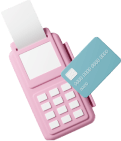Content
- Introduction
- What is a POS terminal?
- Types of POS terminals in Ukraine
- How does a POS terminal work?
- Advantages of a payment terminal for business
- Choosing a POS terminal: Providers
- How to connect a POS terminal at a point of sale?
- How to connect a point-of-sale terminal to RRO
- What are the advantages of utilising a point-of-sale (POS) terminal together with Vchasno.Kasa PRRO?
More and more Ukrainian consumers are paying for goods with bank cards. A study by Master Card has shown that 68 per cent of Ukrainians prefer to make cashless payments and 10 per cent avoid retail outlets where there is no possibility of paying by card.
To accept card payments, stores use POS terminals. In this article, we’ll explain how they work.

What is a POS terminal?
A POS (Point-of-Sale) terminal is a device that allows customers to pay for goods using a bank card. This payment method is convenient for both the buyer and the seller. In particular:
- when the buyer does not have cash;
- when the buyer only has large bills and the seller cannot give change;
- when the buyer receives cashback for paying with a card, etc.
Types of POS terminals in Ukraine
Providers offer different types of POS terminals for different points of sale. Among them, the most commonly used are:
- Stationary. The most common type of POS terminals. They are used at checkout counters in stores, pharmacies, etc. Such POS terminals are connected to the Internet via Wi-Fi or Ethernet cable.
- Portable. They are often used in outdoor retail. In addition to an Internet connection, they need a power source.
- Integrated. Such POS terminals are combined with programs for accounting of goods, financial management, etc. They can be either wired or wireless (accepting payments via NFC).
- Touch screen. They are integrated into self-checkout desks.
To use a POS terminal at a point of sale, an entrepreneur must enter into an agreement with an acquiring bank. Payment by card consists of the following steps
How does a POS terminal work?
Data entry. The salesperson enters the payment amount into the POS terminal using a keyboard, barcode reader, etc.
Card reading. The buyer swipes or taps the card on the POS terminal.
Balance check. The terminal sends a request to the server of the bank that issued the card to check the balance.
Payment confirmation. The bank confirms the payment. Information about the successful payment appears on the POS terminal display.
Issuing a slip. The POS terminal issues a payment slip to the customer. To issue a fiscal receipt, you must connect the RRO or PRRO to the terminal.
The acquiring bank debits the buyer’s card and then transfers the amount to the seller’s account. The terms and conditions of the transfer are set out in the agreement.
The payment process at a POS terminal can vary depending on the acquiring technology used. In particular, mobile POS terminals allow you to pay for goods using a QR code, Tap-to-Phone or other methods.
Advantages of a payment terminal for business
Automation. The payment terminal provides fast and convenient cashless payments. All transactions are instantly recorded, and reports are generated automatically.
Increase in sales. The ability to accept payments by card, smartphone, or other contactless methods increases sales because customers can pay without cash.
Protection of financial transactions. Terminals have a high level of transaction security, reduce the risk of fraud and eliminate the threats associated with the use of cash.
High level of service. Payment via a POS terminal takes only a few seconds, which improves the quality of service. The intuitive interface makes the process convenient for both buyers and sellers.
Choosing a POS terminal: Providers
More than 50 banks operate POS terminals in Ukraine. Each of them offers different tariffs and service packages. Therefore, the seller should first familiarize himself with the conditions in order to choose the best option for his business.
In particular, the majority of banks lease point-of-sale (POS) terminals. The seller may reduce their expenditure on purchasing the terminal, but the tariff will include a monthly rental fee and a commission for each transaction.
It is also important to consider the compatibility of the terminal with the services used by the seller at the point of sale. For instance, restaurants utilize order tracking services, while retail outlets employ warehouse accounting systems, and so on. There is a range of POS terminals available to suit different business requirements.
In order to issue fiscal receipts to customers, it is necessary to combine the terminal with a software cash register. This will streamline the payment processing for sellers and ensure compliance with tax legislation.
How to connect a POS terminal at a point of sale?
Once the seller has selected a provider, a number of steps must be completed in order to connect the POS terminal at the point of sale.
 To sign an acquiring agreement. The seller is required to provide the following documentation: a copy of the passport and a registration number of the record card of the taxpayer, a certificate confirming the existence of a bank account, and documents confirming the ownership or lease of the premises where the POS terminal will be installed. The agreement must set out the procedure for payment for acquiring services, the rights and obligations of the parties, and all other terms and conditions.
To sign an acquiring agreement. The seller is required to provide the following documentation: a copy of the passport and a registration number of the record card of the taxpayer, a certificate confirming the existence of a bank account, and documents confirming the ownership or lease of the premises where the POS terminal will be installed. The agreement must set out the procedure for payment for acquiring services, the rights and obligations of the parties, and all other terms and conditions.
 To connect the terminal. The device is installed by the bank’s employees within two weeks of the agreement being signed. Furthermore, employees provide training on how to operate the POS terminal.
To connect the terminal. The device is installed by the bank’s employees within two weeks of the agreement being signed. Furthermore, employees provide training on how to operate the POS terminal.
 To assign a MCC Code. The acquiring bank assigns a Merchant Category Code (MCC) to the seller, categorizing them according to the products or services they offer, such as products, clothing, entertainment, restaurants or cafés. This enables customers to receive cashback.
To assign a MCC Code. The acquiring bank assigns a Merchant Category Code (MCC) to the seller, categorizing them according to the products or services they offer, such as products, clothing, entertainment, restaurants or cafés. This enables customers to receive cashback.
How to connect a point-of-sale terminal to RRO
The modern POS terminal interface allows users to connect a range of devices, including RROs, barcode readers and more. In particular, sellers frequently connect terminals to cash registers (RRO and PRRO) to issue fiscal receipts to customers.
In accordance with Resolution 894 issued by the Cabinet of Ministers, all points of sale in communities with a population exceeding 5,000 are required to offer cashless payment options. Consequently, combining a physical or software cash register with a point-of-sale (POS) terminal enables businesses to comply with the legal requirements.
In particular, the Vchasno.Kasa RRO (PRRO) is compatible with a range of POS terminals offered by numerous Ukrainian banks. It is important to ascertain the protocol used by the acquiring bank in order to connect the PRRO using Device Manager, a program designed for the management of PRROs and all commercial equipment (terminals, barcode readers, etc.). Register for the Vchasno.Kasa service and add the POS terminal in the settings. If you work through an accounting system, please set up the integration.

What are the advantages of utilising a point-of-sale (POS) terminal together with Vchasno.Kasa PRRO?
The use of a POS terminal together with Vchasno.Kasa PRRO offers a number of advantages:
- it allows you to comply with all tax legislation regarding the issuance of fiscal receipts;
- fiscalizes all types of contactless payments;
- if the bank updates the terminal’s protocols, Vchasno.Kasa controls these changes;
- Vchasno.Kasa PRRO can be easily connected to various types of POS terminals. Fiscal receipts can be generated from the accounting system or from the Vchasno.Kasa web account.
Issue checks according to all the requirements with Vchasno.Kasa!
Get a free consultation and learn more about fiscalization and cash discipline.





